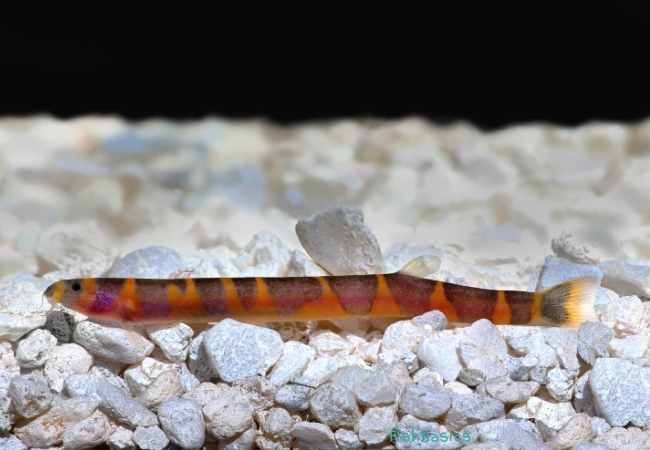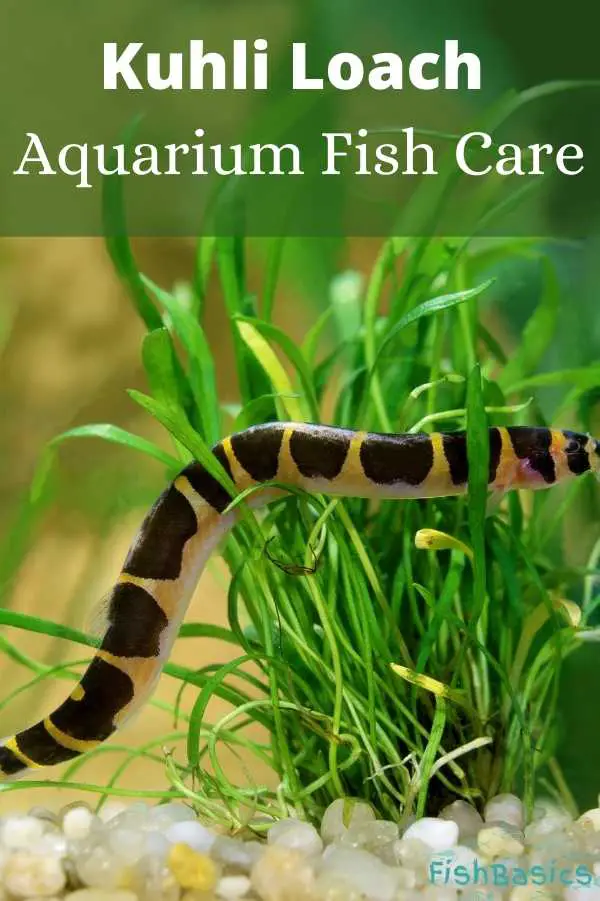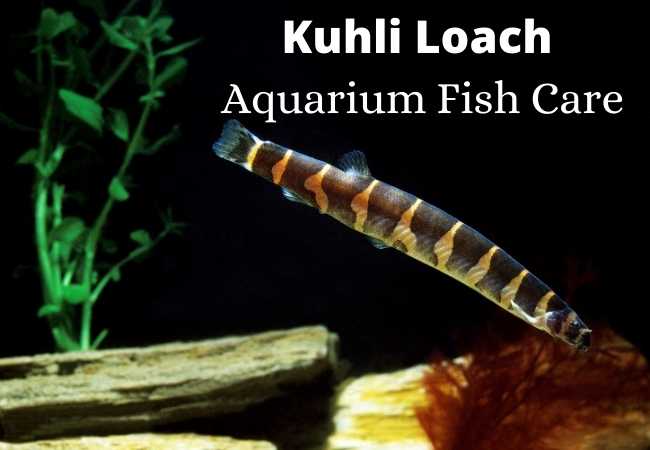Proper Kuhli Loach aquarium fish care will help you get healthy and thriving fish. If you are looking for a great cleaner fish the Kuhli Loach might be what you want. The Kuhli is a freshwater fish, that can do well at the bottom of the tank. To be successful when keeping the fish, you need to make sure that you have not only the perfect equipment but also the right information.
It stays awake at night scavenging for food. It is a great companion for other types of fish, because of its calm temperament.
| Aspect | Kuhli Loach |
| Family | Cobitidae |
| Size | 3-5 inches |
| Lifespan | 10 years |
| Color | Yellow bars |
| Tank Setup | Freshwater |
| Diet | Omnivorous (prefers meat diet) |
| Temperament | Peaceful |
Kuhli Loach Size
The Kuhli Loach has an eel-shaped body, which most fish keepers find attractive. Another attractive feature about the fish is that it rarely grows more than three to five inches in length. The Khuli are native to South-east Asia. It also does not create much waste in the tank.
Although they are small in size the Kuhli Loaches are better suited for the experienced aquarist. This is because they are prone to many diseases. The fish is one of the most sensitive to medications that are used commonly to treat different types of sicknesses and diseases.
They also fall in the category of scale-less fish this is because they have no scales on the head. If you have some experience in taking care of scale-less fish you might find success with this type of fish.
Kuhli Loach Appearance
The Kuhli have a dorsal fin that begins in the middle of their body. The fish also have faint body scales as well as no scales on the head. The fish also have between 10-15 dark vertical bars that run across their body.
Kuhli Loach Colors
There are black varieties of the Khuli fish which don’t have the stripes and are black or dark brown. These varieties are rare to find or even buy. They are commonly referred to as the Chocolate Kuhli Loach. They can grow up to 3.2 inches in length.
The common varieties have bars that have either a yellow or pinkish color running across the middle. There is no much difference between females and males.
However, the males have larger pectoral fins as well as a muscular dorsal cross-section. The ovaries of the females can also be seen filled with eggs just before spawning.
Kuhli Fish Sale
Although the price of Kuhli fish depends on where you’re getting the fish from, the average price is about $3 per fish. It is important to note that the Khuli fish like to stay in groups of about six. If you get just one Khuli, it will most likely be shy and hide all the time.
Khuli Loach Lifespan
The fish can live for up to 10 years. This only possible if your Kuhli Loach aquarium fish care is good and the fish gets all that it requires to thrive.
Kuhli Loach Care
Water
While in their natural habitat the fish live in tropical slow-moving rivers and lakes. When kept in an aquarium the fish should be provided with warm temperatures that range between 73- and 86-degrees Fahrenheit.
The fish also prefer slightly acidic water compared to other aquarium species. The ideal pH should be between 5.5 and 6.5. The tank water should also have a hardness rating of less than 5.5dGH.
Kuhli Loach Tank Size
Kuhli Loach aquarium fish care also includes providing the fish with at least 20 gallons on average. If you decide to have more than one fish in the tank, make sure to add about 3 to 4 gallons of water for each fish.
The Kuhli Loach fish need to have well oxygenated and clean water at all times. I have found great success with having an under-gravel filter that helps improve oxygenation and reduce waste.
It is also important to have frequent water turnover of about 10 times per hour. To achieve these results, you will need a high-quality filter.
It is also important to note that the Kuhli Loach fish are curious and can swing into the filter. To prevent this the filter needs a cover over the outlet and inlet pipe.
The fish also require a soft substrate. The most common types are soft sand and fine gravel mix.
It is also important to provide the fish with sufficient places to hide. This can be in the form of vegetation, such as Java fern. The tank should also be fitted with driftwood as well as artificial rocks and caves. Adding twisted roots will be an added advantage as the fish will have more places to hide.
Although the Kuhli Loach fish spend most of their time at the bottom of the tank, they can also jump out of the tank. It’s therefore advisable to have a firm cover.

Best Tank Mates for Kuhli Loach
Kuhli fish can exist peacefully with all other non-aggressive fish. Some of the common fish types that are kept together with cooler fish include Oto Catfish, Tetras, Red Cherry Shrimp, Danios, White Cloud Mountain Minnows, and rasboras.
The Kuhli Loach fish spend most of their time at the bottom of the tank scavenging, therefore their ideal tank mates are those who spend their time in the middle and upper regions. Some other great tank mates are the pelagic fish such as Gourami.
Some of the types of fish that should not be kept together with the cooler fish include all the popular big territorial fish types.
These include Arowanas, Tiger Barbs, Cichlids, Angelfish, Chinese Algae Eaters, Red-Tailed Sharks, Blue Gourami, and Bettas.
What Do Kuhli Loach Eat?
The Kuhli Loach is omnivorous fish and is comfortable feeding on small crustaceans, larvae, and plant materials.
Although the fish can eat most of the things fed to them, they prefer a meat-based diet. They can successfully live on flakes and pellets.
The fish do not actively hunt for their food rather they wait for it to sink down and actively search for it.
Many people have found success by making homemade recipes as a way of providing their fish with a balanced diet. However, if you don’t want to try this you can use micro worms, bloodworms, daphnia, grindal worms, and artemia.
Kuhli Loach Eat Snails
The Kuhli Loaches are not known, snail eaters. However, they are not picky eaters either. This means that they will try to eat your snails.
Common Diseases for Kuhli
As noted above the Kuhli Loach fish are susceptible to many diseases. Even experienced aquarists can sometimes have trouble managing them. The diseases to watch out for include full:
- Ich
The Ich is also known as the White Spot Disease. The Ich is a common disease among aquarium fish. Every time the fish are attacked, the Kuhli fish are always among the first to be attacked.
- Skinny Disease
The Kuhli fish are often attacked by common parasites that can cause Skinny Disease. If you notice that your fish is losing weight even though you’re providing it with a healthy diet it’s most likely affected by a parasite.
Providing fish with proper medication will get rid of the problem. You also have to give the fish time to recover.
Prevention is better than cure, especially when keeping sensitive fish such as the Kuhli fish. To keep your fish thriving and happy make sure that they have good quality water, a suitable environment, and the fish get a balanced diet all the time.
Kuhli Loach Breeding
The Kuhli fish can be bred after they reach sexual maturity. The fish reach maturity at 2 years old. Breeding the Kuhli Loach fish can be extremely challenging especially if you don’t have the right environment. To be successful you need to set up a breeding tank.
It is important to note that your Kuhli fish has increased chances of spawning within a community of its species. The females spawn together in the right environment.
Make the fish as comfortable as possible by making sure that the light is dim and the water levels are low. The tank should also be fitted with dense vegetation which promotes the female to lay their eggs.
The water pH should also be kept low at about 6.5. The water hardness should also be lowered. During this time the Kuhli Loach fish should also have plenty of food. For best results use live foods.
The mature female adults lay bright green colored eggs that attach to the under leaves of the plants. The eggs hatch after about 24 hours. You can use commercially produced food for the fry as well as brine shrimp or Infusoria.
It is important to note that you should remove adult fish from the tank as soon as the eggs are laid because they can eat the eggs and the fry.
Final Thoughts
The Kuhli Loach is a great fish to have in your aquarium. However, it’s important to note that getting the fish to thrive can be challenging even for experienced aquarists.
I hope you found this post on Kuhli Loach aquarium fish care helpful, if so please share it and also follow me on Pinterest for more useful fish keeping posts.








